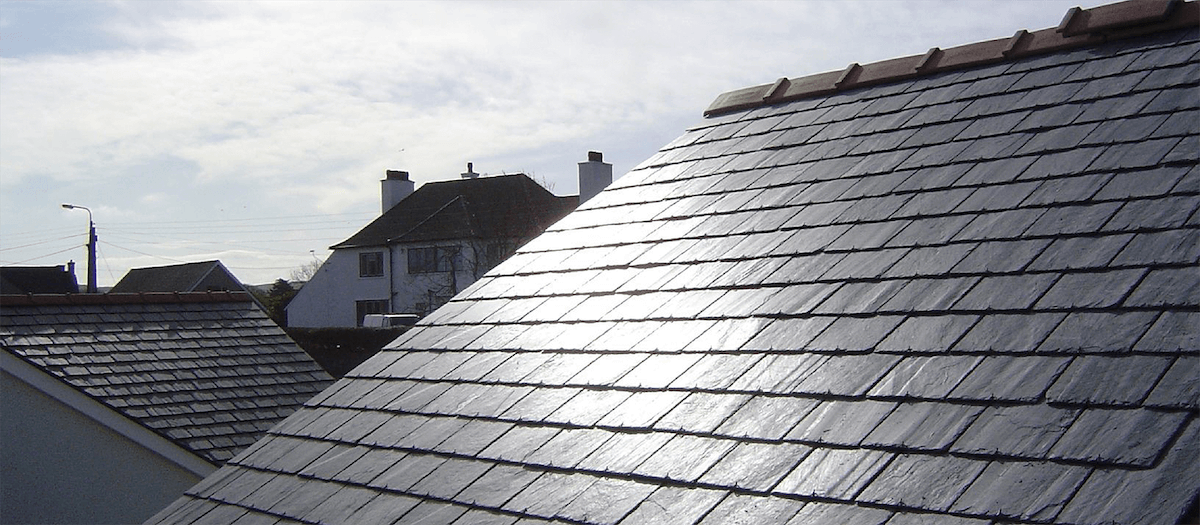Why Choose Slate Over Any Alternatives?

40 years’ expertise
World-class natural slate
Uncompromising quality standards
Guarantees for up to 100 years
Sign up below to gain access to this content

There is no comparison to the finish of a natural slate roof
It’s difficult for any other material to compete with natural slate. The durability of a literally ‘rock hard’ natural material means that a quality slate roof will last a lifetime (or two), while the man-made alternatives need to be replaced once, twice or even three times over the course of the building’s lifetime.
When it comes to aesthetics we’re clearly biased, but it’s hard to deny the style and finish of a quality natural slate roof. For us there simply is no comparison.
Slate vs Fibre Cement ‘Slate’
Imitation. It is the highest form of flattery. And while we do appreciate the compliment, there are some myths that need to be dispelled when it come to natural slate and fibre cement ‘slate’.
Myth #1 – Lack of availability of Natural Slate
In 2012, the estimated global slate production was over 4 million tonnes. That’s a LOT of slate – and from our experience quarrying is nowhere near capacity. So there are PLENTY of natural slates to go round. Yes, some of our best slates are rare and exclusive, but they have always been reserved for the most discerning projects anyway.
Myth #2 – Relative low cost of fibre cement ‘slate’
If you take into consideration the longevity of fibre cement compared to real natural slate – this is simply not true in a lot of cases. Studies show that over a 30 year period, a fibre cement roof will have to be replaced at least once. A natural slate roof however will last up to 100 years and require very little maintenance in 30 years. So over a 30 year period a fibre cement ‘slate’ roof will cost you on average 1.5 times that of a natural slate roof.
So if you can get your hands on quality natural slate and it requires no more investment (and often less) than fibre cement imitation ‘slate’, then why settle for anything less than the real McCoy?
Slate vs Concrete Tiles
When it comes to concrete tiles there are 2 things to remember:
#1. The short-term costs of concrete are generally less than natural slate. However over the life-cycle of the product, taking into account reroofing, the long-term costs of good-quality slate is less. Our best estimates are that over a 100-year period the cost of a natural slate roof is about 80% that of an equivalently sized concrete roof.
#2. The weight/m2 of concrete is usually at least double that of natural slate as the average thickness of a concrete tile is 10-12mm, which inevitably increases costs of construction due to higher handling costs. Longevity and environmental benefits are not comparable simply because of the relatively poor lifecycle of the concrete product (have you stumbled across any recycled concrete roofs recently?).
Slate vs Clay Tiles
Like natural slate, clay tiles come in a variety of colours and qualities. Its short-term cost varies considerably, but overall it is similarly priced to slate. In terms of its environmental impact, however, the production of clay tiles is far more damaging to our world. The production of clay is kiln fired and during this vitrification process more energy is expended and carbon dioxide released, relative to the Natural Slate production process.
Clay tiles also need replacement more frequently, and thus become a less viable alternative to natural slate because the long-term cost becomes an issue.
In terms of aesthetics, this is subjective and depends on the demands of your projects – for us, there is no substitute for natural slate, but don’t take our word for it, have a look at our image gallery here.
The Nitty Gritty…
The tables below offer a brief view of the benefits of natural slate compared to clay tiles, concrete, and fibre cement ‘slates’.
| Roofing Product | Weight | Durability | Maintenance % of initial cost | Re-Roofing Frequency Times |
|---|---|---|---|---|
| Concrete Tiles | 51 | 30 | 10% | 3.33 |
| Clay Tiles | 63 | 40 | 10% | 2.5 |
| Fibre Cement “Slates” | 21-25 | 30 | 12% | 3.33 |
| SSQ Ultra Natural Slates | 20-30 | 100+ | 12% | 1 |
Source: Building Magazine
The Inventory of Carbon and Energy (ICE) Chart below compares Natural Slate against Clay and Concrete Tiles below.
| Product | Embodied Energy (MJ/kg) | Embodied Carbon ((kgCO2/kg) | Life expectancy (Years) |
|---|---|---|---|
| Natural Roofing Slate | 0.1 – 1.0 | 0.005 – 0.054 | 20 – 100+ |
| Clay tile | 6.5 | 0.43 | 40 – 65 |
| Concrete tile | 1.2 | 0.19 | 30 – 50 |
Source: Inventory of Carbon and Energy, University of Bath, 2006